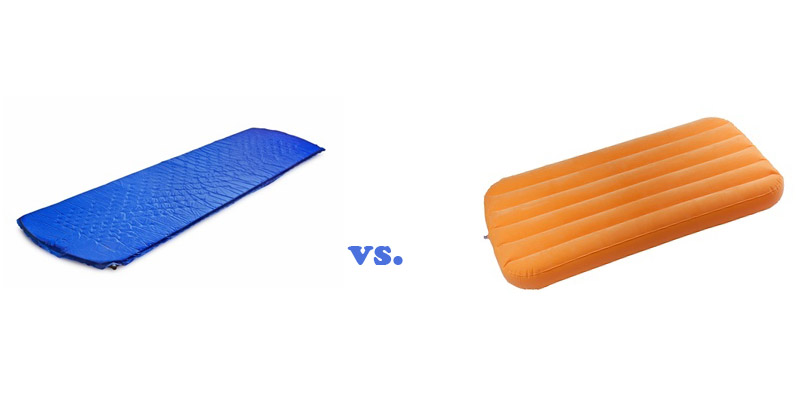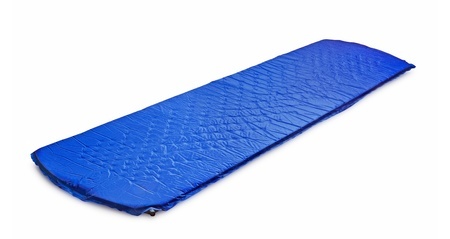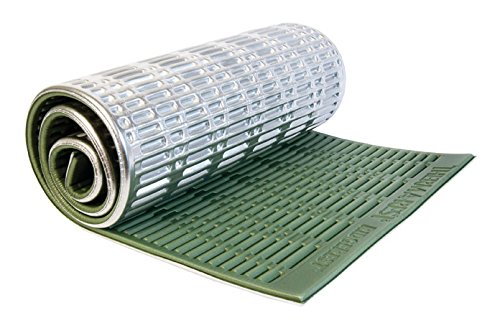
Best Sleeping Pads
For Backpacking And Camping
by Diane Spicer
By Diane Spicer
You are in good company if you're wondering about the best sleeping pads.
Any hiker planning to sleep even one night away from a warm, comfy bed at home ponders this question:
"How do I find the best sleeping pads and then select the one that's right for me?"
The word "best" is a slippery slope, because the best pad for me might not cut it for you, due to differences in our hiking habits, physical dimensions, tolerance for cold hard ground, and so many other factors.
Luckily, there's help available when you're searching for the best sleeping pads for your needs. Maybe you need a:
- backpacking air mattress,
- car camping sleep pad, and
- mattress for home use (when the relatives show up).
Read the following detailed advice for how to size up and select your perfect sleeping pad, provided by James Menta of 3Beds.
Note:
No affiliate relationship exists between Hiking For Her and 3Beds.
However, both of us are in the "business" of providing quality hiking
gear advice to you. And right now, that means an overview of the best
sleeping pads.
All of the following advice, opinions and images are credited to James Menta.
Best sleeping pads
Mother Nature can be both gentle and cruel.
For a hiker, the difference between the two often comes down to making the right choices with our gear.
One of those choices is that of the best air mattress or sleeping pad for your adventure.
It can be confusing, overwhelming, baffling even.
- You can read reviews of the inflatables.
- You can go through what the companies are saying about their products.
But, more often than not, it doesn't solve the issue of YOUR specific needs.
How to choose the right
sleeping pad for your needs
The choice is an important one. It can make or break your trip.
It can be the difference between a night of comfy refreshing sleep, and a night of waiting for the sun to come up wondering, "Why am I doing this to myself?"
Let's make sure the latter doesn't happen, shall we?
Sure, it might seem confusing, but when you break it down, it really isn't.
They say the answer to the question "How do you eat an elephant?" is "One bite at a time."
So, let's eat this elephant in 5 bites...
Bite 1:
Sleeping pad vs. air mattress
 Photo provided by 3Beds
Photo provided by 3BedsAre you driving and setting up camp near your local trail, or taking on a 10-day hike through the rigors of Patagonia?
OK, not many of us are hiking Patagonia these days, but you get my point...
The decision is all about space and purpose.
An air mattress will be your top choice if you have the time and space.
Even the lightest of regular air mattresses are 8-10 pounds (they can go up to 30 or 40 pounds with an EZ bed, one that comes with a frame).
None of these are really an option for backpack hiking.
This one does sound like common sense, I know, but you'd be surprised by how many people I see on the trail with a bulky backpacking air mattress that fills half of their backpack.
Don't be one of those people. If you choose smart and follow the tips we'll go over in this guide to the best sleeping pads, you can get a good night's sleep on a compact and light sleeping pad.
But if you have the space and time, you can read more on how to choose a good air mattress here.
Let us move on to the matter at hand - the choice of a sleeping pad.
Bite 2:
Types of sleeping pads
OK, so you decided to go with a sleeping pad.
The next choice to make is between the three main types:
- Old-school, manually inflated pads
- Self-inflating sleeping pads
- Foam mats
Old-school sleeping pad:
You need to manually (mouth or pump) inflate these pads, and they are rarely a good choice.
They are bulkier, heavier, and a hassle to handle on the trail.
They're also made of inferior materials, and are easily punctured - not something you'd like to see happen, whether it's on your local trail or in Patagonia.
Self-inflating sleeping pad:
 Photo provided by 3Beds
Photo provided by 3BedsWhen you say "sleeping pad", this is what most people think of these days, and rightfully so.
The materials and technologies used for the best of these pads leaves us wondering, "What's next?"
These sleeping pads combine the:
- insulation of a foam layer,
- comfort of air chambers, and
- durability of thick, layered PVC.
The way it usually works is that you just open the valve and the pad inflates automatically within a minute or two.
This is obviously the smart and the most convenient choice.
Foam mats (closed cell):
 Photo provided by 3Beds
Photo provided by 3BedsThis is the cheapest choice but, on its own, it's really only an option for day hikes and rest breaks along the trail.
However, combine it with a good modern pad and you get your comfortable little nest for the night. The foam adds insulation and, more importantly, protects the air pad from punctures.
Bottom line: A self-inflating pad plus a foam mat equals a good night's sleep.
Bite 3:
R Value demystified
Bear with me on this one, it gets complicated before it gets simple.
There's too much fuss about the R-value of a sleeping pad, and it's a common mistake to judge a pad based on its R-value.
IT IS NOT a measure of quality.
It's a measure of insulation. That's what the R stands for: RESISTANCE to changes in temperature.
You can find pads with an R-value of up to 9.5.
IT IS NOT UNIVERSAL, so be careful if you are making decisions based on comparing R-value across brands.
Now, what I just said might raise some eyebrows.
It should be a standard value, right?
Kind of...
Strictly speaking, it is a standard value but there is NO standard when it comes to measuring it.
Let me be direct here - I know for a fact that some companies don't even measure it, but just give estimates.
This is where we'll make it simple. Two rules to steer by:
1. It is my opinion that the cutoff point for R-value is somewhere around 3.
By "cutoff point", I mean the line between a pad used for winter camping, and one for the other three seasons. Simply put, if there's a chance of using the pad in the cold, don't go below 3.
This is especially true for women, who tend to be cold sleepers.
2. Look at R-value per ounce.
Simple - if you are in a dilemma between a few models, go with the one that provides most insulation (highest R-value) per ounce.
You'll be surprised by how a small "jump" in weight can double the R-value.
These are the kinds of connections to look at instead of taking a sleeping pad's R-value as-is.
It's this kind of thinking that will fine-tune your backpacking trip.
Bite 4:
Width and length
of the best sleeping pads
How long?
A sleeping pad HAS to comfortably fit your shoulders and hips.
For a winter hike, don't go below regular length (usually 72 inches). This will keep your feet comfortable and insulated, which makes all the difference on a chilly night.
On the other hand, modern sleeping pads pack small and light, so the difference in packing size between a short and a regular length pad isn't worth risking your health over (unless you are an extreme, ultra-light hiker aiming to shed every possible ounce).
How wide?
The standard for sleeping pads is 20 inches.
If you're a restless sleeper, you might consider going with a wider version, usually available in 25 and 30 inches.
The best choice for women
The industry generally doesn't pay enough attention to adjusting the gear to the specific needs of women.
When it comes to sleeping pads, a woman will need more insulation at the hips and feet.
There are very few models that specifically list "sleeping pad for women".
If you don't like any of those choices, and you want to shed a bit of extra pack weight, go with a semi-rectangular or a mummy-shaped pad.
Bonus bite:
A few tips on sleeping outdoors (optional read)
- Make sure you are dry before you hit the sack... and when I say dry I don't mean the obvious not-soaking-wet kind of dry. I am talking about changing your clothes if you feel sweaty. Take it from me, pneumonia is a harsh teacher.
- Drink something warm about half an hour before going to sleep (warm, not hot). This will soothe your mind and body without the sweat kicking in again.
- No alcohol before sleep. I know it's tempting to spice up your coffee with a bit of rum, but it's not a good idea. The alcohol will warm you up a bit but it will interfere with your body's ability to regulate its core temperature. I know it's a favorite ritual for a lot of you out there, but don't kill the messenger, it's a scientific fact.
- No deodorant. If you are using cosmetics, go with the odorless. The smell attracts bugs and mosquitoes.
- Sage on fire: Sage is a great mosquito repellent, so if possible, have a branch in your pack and throw it into the camp fire. Works every time.
- Waterproof repellent: If you are using a bug repellent and still seeing hordes of annoying gnats, it's most likely because your sweat has watered down the repellent. Check the label and look for the word "waterproof".
- Just lay there for a while. After a long day, your blood is still rushing and you might feel OK and warm. Don't fall asleep right away and see if you feel warm in 10 minutes. Chances are, you might need an extra layer.
- Synthetics (and wool) beat cotton as insulators. Choose these for the outer layer of your sleeping arrangement.
- Get creative. Make the best of what you have and improvise. There would be no excitement if hiking wouldn't put you outside your comfort zone every now and then.
- You can't get comfortable.
- Your pillow might be slipping and your neck is stiff from trying to control it.
- Your body might feel OK but your feet are freezing...
Improvise.
- Pull a T-shirt over your sleeping pad, and wrap the pillow into another. This will stop the slippage.
- Wrap your feet in an extra layer, a shirt or whatever you have on-hand. It will warm up your feet, and you'll be in for a pleasant surprise when you slip into the same warm T-shirt in the morning.
Elephant eaten
A step-by-step map of choosing the best sleeping pads can only get you so far.
The rest comes down to your taste and preferences. It's a cliché, but it's true.
The important thing is that you now know the crucial DOs and DON'Ts.
In conclusion, you'll rarely have everything you need, but you'll always have the resourceful mind of a hiker.
You'll just have to nurture and feed it first.
Hopefully, you'll find this guide to be good food for thought.
Stay on the trail,
James
Now you know how to choose the best sleeping pads
Thanks, James, for providing lots of great facts and some advice to think about when selecting the best sleeping pads for outdoor adventures.
Sleep is one of your most important assets as a hiker, especially a woman going solo.
- The best decisions are made with a clear head, with the underlying assumption that you've had a great night's sleep.
- Do everything you can to get warm, stay warm, and enjoy a restful sleep atop one of the best sleeping pads you can find.
- Don't be that sleepy woman on the trail!
Maybe SLEEP should be the Eleventh Essential?
(See Hiking Ten Essentials if you aren't sure about this little pun.)
If you're ready to consider a total sleeping system, your next decision awaits:
You can also start at the beginning, with the components of a great sleep system for backpacking and camping.
Home page > Best Hiking Gear >
Best Sleeping Pads For Backpackers And Campers
|
I get emails all the time about what I wear, eat, carry and love to use on the trail. That's
why I provide affiliate links to you: the best gear that I use myself and have seen used by other hikers is instantly
available for your consideration, and the gear company sends a few
pennies per dollar to this reader-supported hiking website. There is no added cost to you! Everyone ends up a winner: Great gear for you, strong gear companies, and more free hiking tips for everyone. Thanks very much for your support. It's warmly and sincerely appreciated. It also helps send these hiking tips to all your virtual trail buddies around the globe. |
 |

